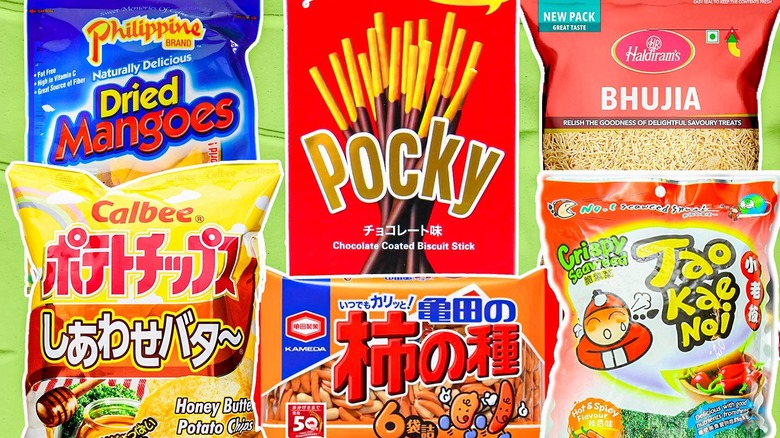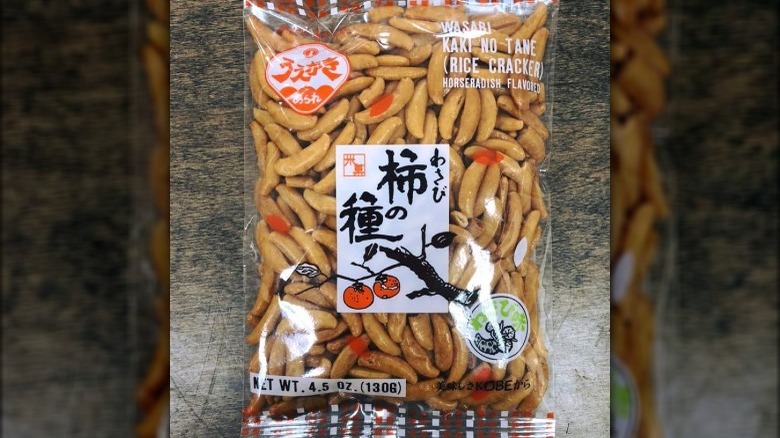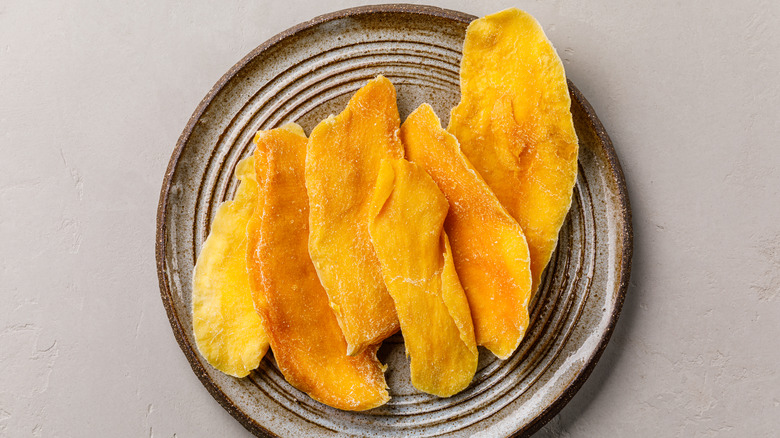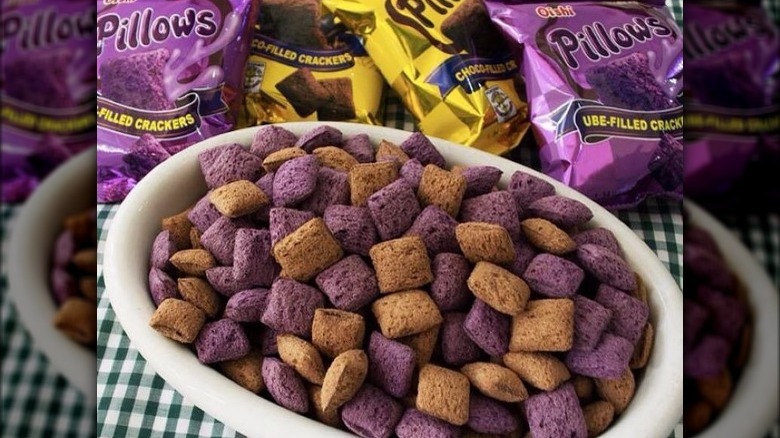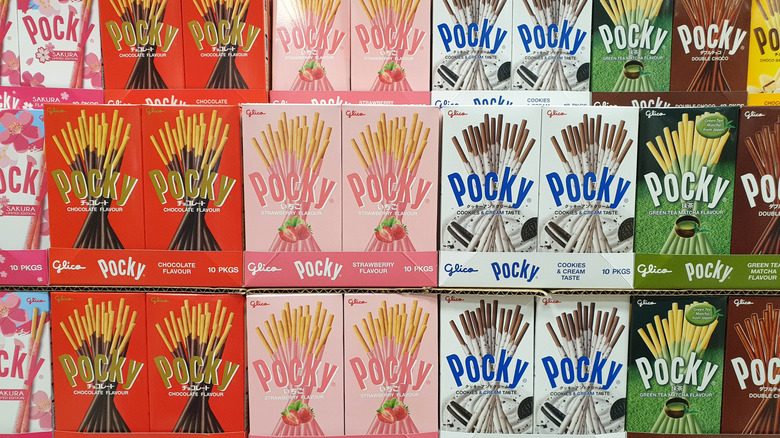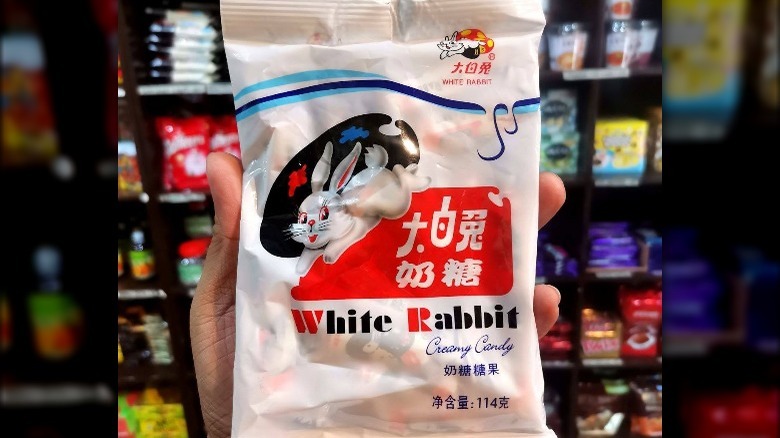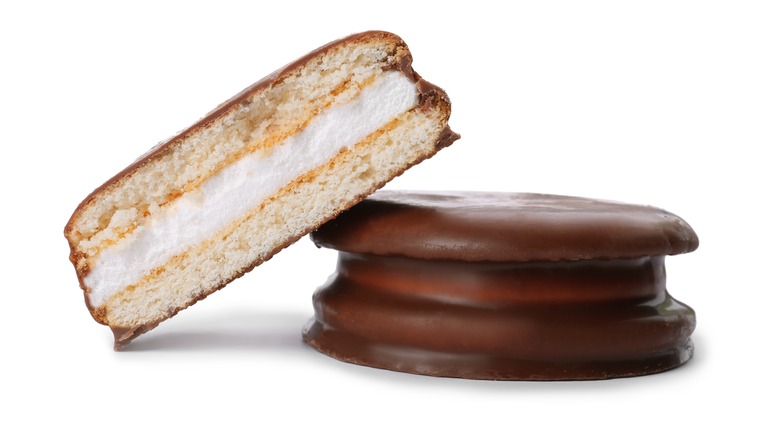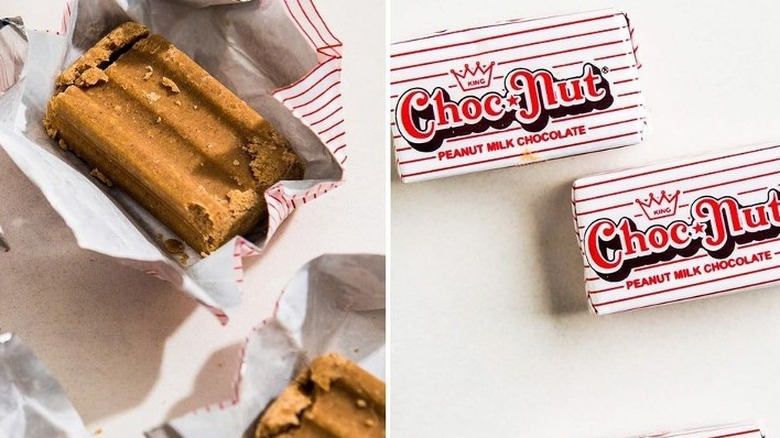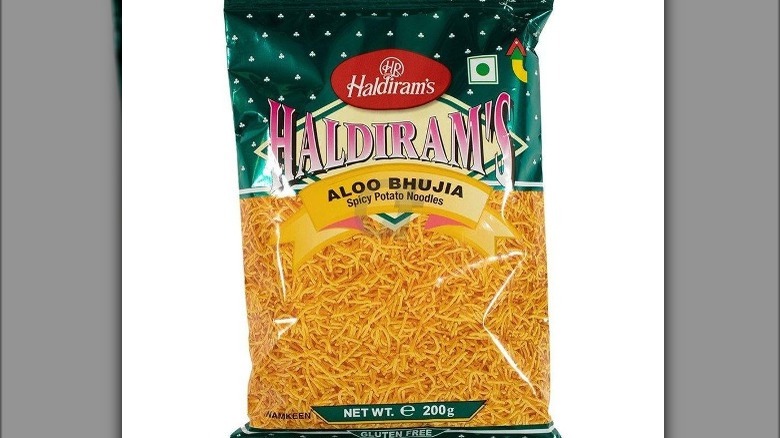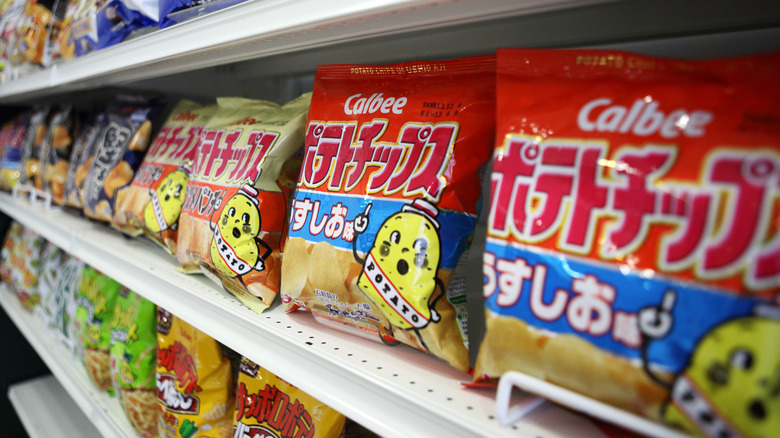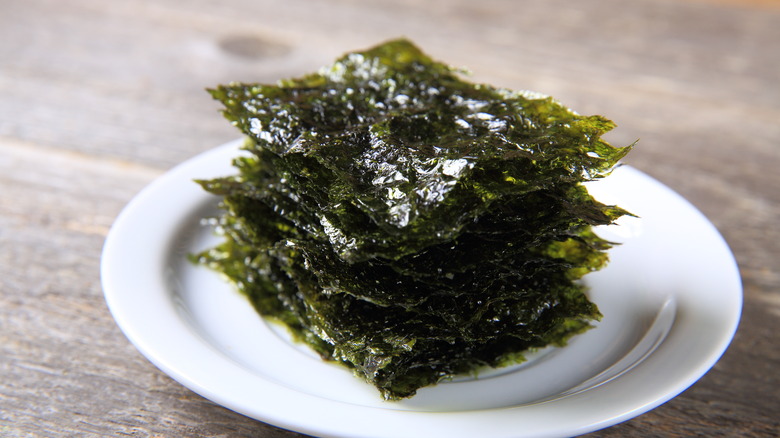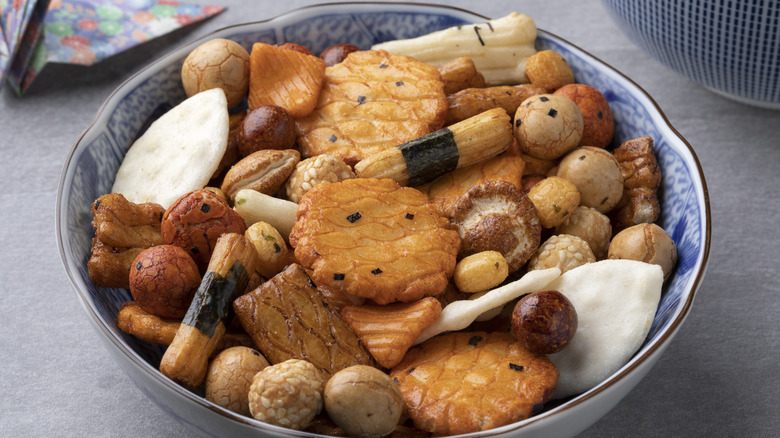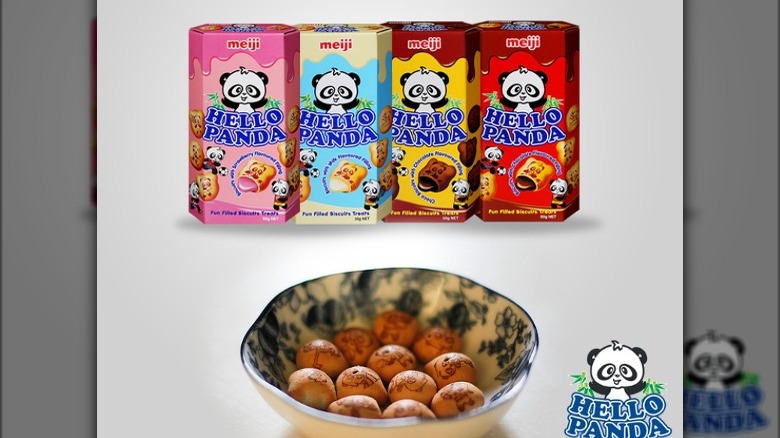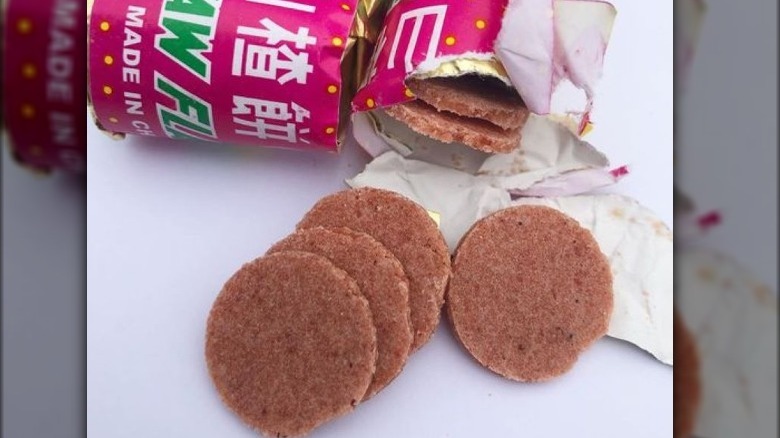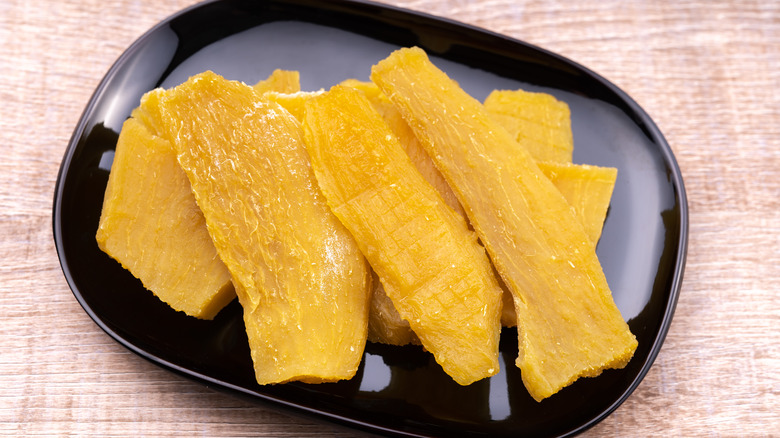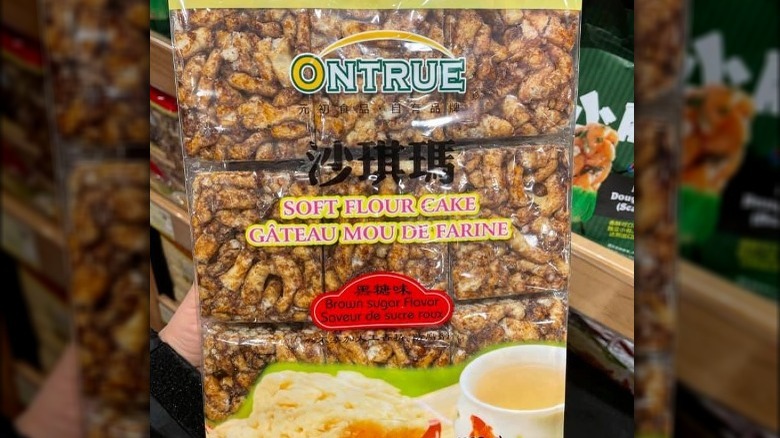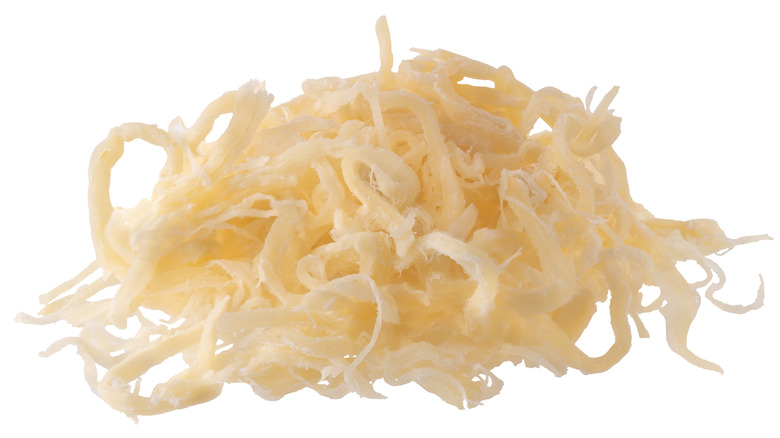Snacks You Need To Buy On Your Next Trip To An Asian Grocery Store
Snacking is not dictated or limited by regions and borders. Regardless of diet and location, most people like to nibble on something in between meals. This is the food that provides a short burst of energy and keeps us running on a hectic day, at least until the next proper meal. Snacks can be savory or sweet but never complicated, too elaborate, or overly heavy.
In the snacking narrative, no one does it better than Asia, and even if you haven't been lucky enough to travel and witness that continent's glorious snacking culture, you have probably seen the rich snack displays at your neighborhood Asian grocery store. The sheer number of Asian snacks can sometimes be intimidating, and the packaging may get confusing. All of this can be overwhelming and quickly deter you from trying some of the best Asian snacks.
However, if you are determined to diversify your snacking portfolio, this is the best place to start. Browse through the list and have a hassle-free experience on your next visit to the Asian grocery store.
Kaki no tane
Kaki no tane is one of the ultimate Japanese snacks. These incredibly crispy rice crackers are easily recognized for their unique oblong shape. The classic version is flavored with soy sauce and seasoned with just a touch of spicy chili, but you can find editions with some typical Japanese flavors such as wasabi or umeboshi — preserved ume fruit — or some less traditional versions that are coated in chocolate. Kaki no tane is often packed on its own, but mixes with peanuts are also common and are usually labeled as kakipi.
Kaki no tane is truly a historic Japanese snack with origins that date to the mid-1920s. Allegedly, the invention was purely accidental when Yosaburo Imai cracked the metal mold used for rice crackers. He ended up with the weirdly shaped version, which eventually proved to be a big hit. The name kaki no tane, which literally translates as persimmon seeds, is a reference to the unique seed-like shape. Kaki no tane is the ideal snack to pair with a drink, so if you haven't tried it before, grab a bag and make sure you have a drink in hand.
Dried Filipino mangoes
Dried mango might not be exclusive to Asian grocery stores, but there is a legit reason why you should always look for the Filipino mango. The Philippines is a well-known mango producer, and the mango coming from this Asian archipelago is usually dubbed as one of the best-tasting in the world. The cultivar mostly associated with the Philippines is the Carabao mango, distinguished for its tender flesh, vibrant yellow color, and incredible natural sweetness.
If you are not traveling to the Philippines, where there is an abundance of fresh mango to snack on, the second best option is to get a bag of dried mango that was produced in the Philippines. Even in the dried form, you can taste the juiciness and the sweetness that is usually accentuated with a sugar crust. Sure, we should always try to eat fresh, but dried fruit is a great alternative, and despite the sugar, it is probably one of the most nutrient-dense snacks at grocery stores and ideal for snacking.
Pillows
Pillows are one of the legendary Filipino snacks commonly sold at Asian grocery stores. These wheat and rice crackers are made with a thin, chocolate-flavored shell and a silky chocolate filling. As you may guess, the name refers to the square, pillow-like shape of the crackers. They are small and compact, ideal for munching down at any time of the day.
Pillows are produced by Oishi, a Filipino company founded in the 1970s. The business started with prawn crackers but now includes a variety of sweet and savory crackers and chips. Apart from the original chocolate-flavored Pillows, the most popular variety is the vibrant purple version flavored with ube – a variety of purple yam originating from Southeast Asia. Ube is used as a flavoring in the cracker shell and the filling. Some less common editions include the savory cheese-flavored varietyand the one flavored with durian — an Asian fruit infamous for its pungent smell.
Pocky
Pocky is a Japanese snack with an international reputation. This legendary treat is made with a thin, long biscuit dipped in creamy chocolate. The bottom of each stick is left plain, which allows a hassle-free, convenient snacking experience so you can avoid messy chocolate-covered fingers. Original Pocky was released in 1966 and has since become a favorite among Japanese sweet snacks. The original chocolate version is now joined by other varieties that use familiar Japanese flavors such as matcha or international favorites like caramel or cookies and cream. Some versions are also coated with crushed cookies or nuts for an added crunchy kick.
If you are already a die-hard Pocky fan, you should also try Toppo. This sweet snack is best described as an inverted Pocky, meaning the chocolate is tucked inside the thin, elongated biscuit. Toppo also comes in a variety of flavors. Dark chocolate is the gold standard, while other popular options include caramel, chestnut, and strawberry flavors.
White Rabbit
White Rabbit is a time-honored Chinese candy that is well-known among Asian confectioneries. Best described as a milk-based candy, White Rabbit comes wrapped in an edible rice wrapper that helps to hold the candy's shape and keeps it moist and chewy. The packaging is quite distinctive, easily recognized by the red, blue, and black design and, of course, an image of a white rabbit, which replaced the Mickey Mouse sketch that decorated the original version. It's easy to understand why this humble candy is a favorite for so many people. The original flavor is mellow and mild — you can almost describe it as retro — faintly reminiscent of milk and vanilla. The chewy texture makes the eating experience fun, which is what you want in a candy.
Apart from the classic milky version, you can find other flavor options. The original is still a favorite and the easiest to get outside of China, but if you are lucky, you might come across some more adventurous options that add chocolate, matcha, red bean, or yogurt. If you like the original flavor, look for the White Rabbit ice cream, which was even sold by American Costco outlets at one point.
Choco Pie
Choco Pie is probably one of the more familiar Asian snacks on the list. This classic consists of two soft sponge cakes held together with a feather-light marshmallow filling, all coated in a thin layer of chocolate. The pies are individually wrapped and are typically sold in a 12-pack box.
Orion is a South Korean snack mogul that first started producing Choco Pies in 1974. The snack ended up being a big hit and is still considered one of Orion's flagship creations. Apart from the original version with a marshmallow filling and a chocolate glaze, the company currently has a banana-flavored version with a soft and gooey banana cream filling. Orion's Choco Pie is not the only snack pie you can find at Asian grocery stores. Lotte Confectionery distributes a similar treat with the same name, but we'll let you decide on your favorite.
Though this has never been officially confirmed, Choco Pie was most likely modeled after American MoonPie desserts, which came out in 1917.
King Choc Nut
Choc Nut has a cult status among Filipino sweets. This somewhat unusual candy bar is a mix of chocolate and milk powder, sugar, vanilla, and roasted peanuts, but it is unlike any other chocolate candy you might have tried before. The texture of Choc Nut is almost powdery. It instantly crumbles and starts to melt in your mouth, slowly releasing sweetness and all those chocolaty and nutty flavors.
This is one of the most nostalgic Filipino treats that has been around since the 1970s, and you should have no problems getting it at Asian grocery stores, especially the ones specializing in Filipino products. Choc Nut is conveniently packed and wrapped in distinctive retro packaging. It comes in individual, bite-sized portions, but you have to carefully open the package due to the crumbly nature of the candy. Hany is a similar Filipino treat that can be a nice substitute if Choc Nut is unavailable. Both products are currently manufactured by the same company.
Bhujia
Bhujia is a savory snack usually made with chickpea flour (besan) that originated in Rajasthan, India. It is one of the ultimate Indian snacks that is available at Asian grocery stores. The most famous version comes from the city of Bikaner, where the dish was invented and is still sold at street stalls. Bhujia is often produced with besan or the rare flour variety made with local moth bean, but other types can sometimes be added to the mix. The version with potatoes is also standard, and you'll see it labeled as aloo bhujia. Apart from flour and potatoes, bhujia includes a variety of added spices that provide most of the flavor. This snack has a distinctive noodle-like shape that is ideal for snacking.
Bhujia is not a snack that you should munch on its own. Because of its convenient size, spicy flavor, and pleasant crunch, it is an excellent addition to other dishes. Use it as a topping on soups and rice bowls, or incorporate it into salads, sandwiches, or fried rice.
Flavored Calbee chips
Japan is one of the leaders in the Asian snack industry, and Calbee is one of its most reputable and long-standing brands. It was founded in 1949 by Hiroshima native Takashi Matsuo. Though the business started with caramel production, it soon moved on to savory snacks by introducing wheat-based crackers modeled on the traditional rice version. The company cemented its status with Kappa Ebisen — the shrimp-based crackers that are still a popular snacking option in Japan.
Calbee launched the first potato-based chips in 1972. Since then, it has built an impressive range inspired by international and traditional Japanese flavors such as soy sauce and seaweed. Apart from the classic shape, its chips differ in size and texture, ranging from the thick ridged versions to the light and crisp varieties. Of course, all editions have a wide selection of flavors.
If you want to experiment further, look for the Jagabee label with thick potato sticks — which are clearly modeled on classic fries — made with baked, unhusked potatoes. There are many Japanese chips worth trying, but consider Calbee the reliable, foolproof option with enough flavors to suit everyone's taste.
Roasted or fried seaweed
Seaweed is no stranger to Western palates as many have learned to appreciate and love its flavor and texture thanks to international favorites such as sushi and ramen. But some people still shun away from eating roasted or fried seaweed as a snack. It's high time we realize the great potential of this umami-packed ingredient.
Roasted and fried seaweed snacks are produced in many maritime Asian regions, and you will easily find them at Asian stores worldwide. The roasted version will have that crisp seaweed texture and characteristic briny flavor. It is a versatile option you can eat on its own or easily incorporate into dishes. Fried seaweed is an even crunchier version that is ideal for snacking. Both types are seasoned with salt or different spices, such as chili or wasabi.
Seaweed is a low-fat, gluten-free ingredient packed with vitamins and nutrients. It is often labeled as a superfood, which makes seaweed snacks one of the healthiest options at Asian stores.
Senbei rice crackers
Senbei or sembei crackers are traditional Japanese snacks that goes back to the eighth century. Because they are such a staple, you will easily find pre-packed versions at most Asian grocery stores. Though senbei are usually made with sticky rice and come labeled as rice crackers, some regional variations will use other main ingredients or different types of flour.
Senbei can be fried, roasted, or baked, and it comes in endless varieties that differ in shape, size, and flavorings. The classic version will include traditional Japanese flavors such as soy sauce or mirin, but the combinations can include anything from crushed seaweed and sea urchin to spicy chili flakes. One traditional version even comes wrapped in nori, while some regional varieties lean toward the sweet side and come topped with a crunchy sugar crust. Whichever type you choose, it will make a quick and tasty snack. For an authentic Japanese experience, you should partner classic senbei with a glass of tea.
Hello Panda cookies
Hello Panda are small, bite-size Japanese cookies packed with various traditional and innovative sweet fillings. As you may have already guessed, the name derives from the adorable panda design imprinted on each cookie shell.
Hello Panda cookies are produced by the Japanese Meiji Company. The product was initially launched in the 1970s and was mainly enjoyed by school kids as a convenient treat that could be munched on the go. The first version was a classic cookie paired with a chocolate filling, but since then, the company has released different flavor combinations that feature strawberries, vanilla, caramel, and matcha green tea. The packaging is as cute as the cookie, each depicting a giant panda doing a particular sport. Despite the overload of cuteness, Hello Panda cookies are not exclusively designed as a kid treat, so feel free to reach for these cookies whenever you need something sweet that is equally fun to eat.
Haw flakes
Haw flakes are one of the essential Chinese food items that does not compare to anything that you have tried before. Essentially, these are round-shaped, delicate, and relatively thin sweets made with hawthorn, a fruit from the eponymous tree that grows in Eastern Asia. Hawthorn has a reddish hue and a subtly tangy taste. It is commonly used to make preserves and sauces.
The texture of haw flakes is tender and crumbly, and they slowly dissipates in the mouth. The flavor is dominated by subtle bitterness and faint tartness from the hawthorn fruit that is nicely partnered with light sugary sweetness. You will easily recognize haw flakes at your local Asian store as they come packed in bright pink, tube-shaped containers. Though haw flakes might be one of the items that fall in the acquired taste category, you will never know whether you are a hawthorn fan until you try it. Haw flakes make a great afternoon pick-me-up, especially when paired with tea, and they can be easily incorporated into desserts.
Korean dried sweet potato
South Korea has a special relationship with sweet potatoes. This root vegetable is heavily featured in South Korean cuisine, so it is not surprising that the country is among the biggest producers of the convenient snack that has sweet potatoes playing the leading role.
Dried sweet potato is not one of the most popular items on this list, so it might not be so easy to get one, but some better equipped outlets or those specializing in Korean specialties might offer it. The potatoes are cut into strips or sticks and come packed in convenient sealed packages, ideal for snacking on the go. They are chewy and retain the earthy and sweet qualities we usually associate with sweet potatoes. Apart from its lovely texture and pleasant flavor, this is a nutrient-rich snack. As it is usually minimally processed and always made with real veggies, dry sweet potato might be the most wholesome Asian snack.
Sachima
Sachima is one of the classic Chinese snacks and should be easy to purchase at your local Asian shop. In its basic form, sachima consists of bits of fried egg dough mixed with sugar syrup. The combination is usually shaped into rectangles and given time to set.
Sachima originated in northern Chinese provinces but is now considered a national treat, traditionally feasted on during Lunar New Year. It is produced by numerous manufacturers and comes in many regional varieties that usually highlight additional ingredients beyond the base mix. For example, Cantonese people traditionally add raisins, and then they sprinkle the whole thing with sesame. Sachima can vary in texture, but you can always expect to come across crunchy bits and taste the almost caramelized sugary sweetness in the flavor. This snack can work well on its own, but it would also make a great accompaniment to a cup of tea.
Dried squid
Many people will probably deliver a rapid and definite no on the dried squid listing, but hear us out on this one. Dried squid is one of the snacks that does not have a counterpart in traditional American cuisine. In Asian stores, you will usually find sliced-up or shredded pieces of dried squid neatly packed and ready for snacking.
Yes, dried squid has an intense aroma and flavor, but somehow it works — in a good way. The texture is tender, but the squid has some resistance and chew. Despite the pungent aroma when you munch down on it, dried squid will deliver a kaleidoscope of savory flavors, combining sweet, salty, and spicy in a unique experience that might even convert you into a fan. If you are still not convinced, try flavored versions before tackling the original.
Besides nibbling on it straight from the bag, you can also used dried squid as a great condiment to your dishes. It will provide some depth and give any dish that distinctive umami touch.
